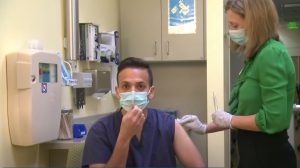NEW YORK (Reuters Health) – Patients with age-related macular degeneration treated with the anti-VEGF monoclonal antibodies bevacizumab and ranibizumab do not have any higher rates of mortality, MI or stroke than those treated with photodynamic therapy, according to findings reported in the October issue of the Archives of Ophthalmology.
Dr. Lesley H. Curtis and colleagues at Duke University School of Medicine, Durham, North Carolina, note that bevacizumab and ranibizumab are both derived from the same monoclonal body, and that bevacizumab (Avastin) used in chemotherapy regimens has been associated with increased thromboembolic risks.
Despite regulatory approval of ranibizumab for treating age-related macular degeneration in 2006, off-label use of bevacizumab has continued because of the price difference. “We use Avastin off label, buy the full vial of drug from a pharmacy, then get about 40-50 doses per vial — about $20-40 per dose,” Dr. Scott W. Cousins, the ophthalmologist on the team, explained via email. Ranibizumab (Lucentis) costs $1950 per injection.
To investigate the safety of the agents, the researchers conducted a retrospective study of 146,942 Medicare patients treated for age-related macular degeneration. The main outcome measures were all-cause mortality, incident myocardial infarction, bleeding, and incident stroke associated with bevacizumab, ranibizumab and the older treatment, pegaptanib octasodium, compared with photodynamic therapy.
After adjustment for baseline characteristics and comorbidities, the risk of all-cause mortality at 1 year with ranibizumab was significantly lower than with photodynamic therapy (hazard ratio 0.85) or pegaptanib (HR 0.84). Also, the hazard of MI was significantly lower with ranibizumab than photodynamic therapy (HR 0.73).
Mortality and MI risk with bevacizumab were not significantly different from any of the other therapies.
Furthermore, there was no significant association between any treatment and bleeding events or stroke.
“News of the drugs’ safety should allay patients’ fears,” said Dr. Cousins. “They always ask us about the side effects of the injection. Now I can tell them that these medications appear to be safe in the absence of high risk factors.”
He added that the results are also important for ophthalmologists, who aren’t in a position to observe any systemic impact of the drugs they prescribe.
“We don’t take care of the whole patient, we take care of the eye,” Dr. Cousins commented. “If the treatment creates a complication, but you’re not the doctor treating the complication, you may not notice you’re causing an adverse reaction. Therefore as ophthalmologists, we may inadvertently miss some of these complications if they had occurred. Fortunately, it appears we haven’t missed them in the majority of patients.”
Arch Ophthalmol 2010;128:1273-1279.




